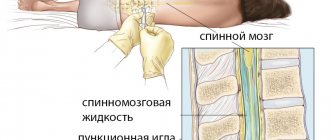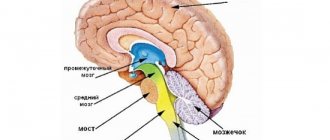Our clinic specializes in the diagnosis and treatment of diseases of the nervous system, incl. non-surgical treatment of increased intracranial pressure and hydrocephalus. You will also find help in treating the consequences of intracranial hypertension: depression and nervous exhaustion, vegetative-vascular dystonia, headaches, visual disorders and others. We will be happy to help you!
- Increased intracranial pressure: treatment at the Echinacea clinic with and without medications
- Make a diagnosis
- Symptoms of increased intracranial pressure
- Causes and consequences of increased intracranial pressure
- What is intracranial pressure
- What is hydrocephalus of the brain
Increased intracranial pressure: treatment at the Echinacea clinic with and without medications
We actively use methods to normalize intracranial pressure, both classically and without drugs. Some simple measures may be enough to get you back to good health. The effect is usually noticeable already in the first week of treatment.
1. Unloading the venous bed of the head using special methods of soft manual therapy and osteopathy;
Normalization of intracranial pressure: for treatment, sometimes it is enough to eliminate the infringement of blood vessels by the vertebrae
2. Special gymnastics to reduce intracranial pressure (used by the patient independently, developed by the doctor after examining muscle tone); 3. Individual drinking/eating regimen.
Living with increased intracranial pressure is both unpleasant and harmful. The human brain cannot work normally under the influence of excess pressure ; moreover, slow atrophy of the brain substance , this leads to a decrease in intellectual abilities, disruption of the nervous regulation of internal organs (hormonal disorders, arterial hypertension, etc.). Therefore, we will take measures to normalize intracranial pressure as soon as possible.
In the treatment of increased intracranial pressure, it is important to reduce the release and increase the absorption of cerebrospinal fluid. Traditionally, it is customary to prescribe for this purpose drugs that reduce the production of cerebrospinal fluid and improve venous outflow (evacuation of venous blood from the cranial cavity). Often it is enough to take the medicine 1-2 times a week.
But still, we strive to free our patients from constant medication use. There are two ways to do this:
- If possible, eliminate the cause of increased intracranial pressure and hydrocephalus;
- Use more non-drug methods for treating cerebral hydrocephalus.
What to do in very severe cases
In very severe cases (for example, cerebrospinal fluid block after neurosurgical operations or congenital cerebrospinal fluid block), surgical treatment is used. For example, a technology has been developed to implant tubes (shunts) to drain excess cerebrospinal fluid.
Make a diagnosis
Intracranial pressure can be directly measured only by inserting a special needle with a pressure gauge connected to it into the fluid cavities of the skull or spinal canal. Therefore, we do not use direct measurement of intracranial pressure.
On the left is an MRI scan of a normal brain. The brain matter is shown in gray, the cerebrospinal fluid is in white. Normal size of the fluid spaces of the brain (they are slit-like). The ventricles are visible inside the brain. The subarachnoid spaces are the white border around the brain.
In the center there is internal hydrocephalus. Excessive accumulation of cerebrospinal fluid inside the brain in the form of a butterfly is visible. On the right is external hydrocephalus. External hydrocephalus is also an excessive accumulation of cerebrospinal fluid outside the brain in the form of a wide white border. The volume of the brain matter is reduced - brain atrophy from fluid pressure
We can confidently judge the increase in intracranial pressure based on the following data:
- Dilation and tortuosity of the fundus veins is an indirect but reliable sign of increased intracranial pressure;
- Expansion of the fluid cavities of the brain (internal hydrocephalus of the brain, external hydrocephalus) and external hydrocephalus (rarefaction of the medulla) along the edge of the ventricles of the brain, clearly visible on computed x-ray tomography (CT) or magnetic resonance imaging (MRI);
- Violation of the outflow of venous blood from the cranial cavity, established using ultrasound vascular studies.
How much the brain suffers from increased intracranial pressure can be judged from EEG data. The gold standard for instrumental examination of patients in our clinic is an assessment of symptoms, brain tomography , fundus images and EEG .
Good optics helps us see the subtle nuances of the fundus vessels
Echoencephalography (Echo-EG) provides indirect and not always reliable data on increased intracranial pressure; it is less reliable than CT and MRI, so we do not use this method.
How is intracranial pressure measured in our children now? (from open sources)
Unfortunately, there is not yet a device that can quickly measure intracranial pressure without performing surgical manipulation in the same way, for example, as a tonometer measures blood pressure.
ICP can be measured directly only by inserting a special needle with a sensor connected to a monitor into the spinal cord canal or into the ventricles of the brain. This method, of course, is used in extremely rare cases.
Therefore, increased intracranial pressure in children and adults can be indirectly judged by:
- tortuosity and dilatation of fundus veins;
- expansion of the ventricles of the brain and rarefaction of the brain substance along the edge of the ventricles (determined by magnetic resonance imaging (MRI) or computed x-ray tomography (CT));
- disruption of venous outflow from the cranial cavities (determined by ultrasound examination of blood vessels).
Intracranial pressure in infants before the fontanel closes can be measured using ultrasound of the brain. In this case, not only ICP is determined, but also the state of brain tissue and fluid. In addition, increased ICP in infants is indicated by a swollen, pulsating fontanel and, of course, symptoms.
Symptoms of increased intracranial pressure
Increased pressure on the brain substance can disrupt the functioning of the central nervous system. Hence the characteristic symptoms:
- Heaviness in the head or headaches that increase in the morning or in the second half of the night;
- In severe cases, nausea and/or vomiting in the morning may occur;
- Vegetative-vascular dystonia (sweating, a drop or increase in blood pressure, palpitations, lightheadedness, etc.) is an almost obligatory symptom;
- Fatigue, “dullness”, easy exhaustion during work or study loads;
- Nervousness;
- “Bruises” under gases (if you stretch the skin under the eyes in the area of the “bruise”, dilated small veins are visible);
- Possible decrease in sexual desire and potency;
- If the human body is in a horizontal position, cerebrospinal fluid is released more actively and absorbed more slowly, so intracranial pressure and its symptoms tend to peak in the second half of the night or in the morning;
- The lower the atmospheric pressure, the higher the intracranial pressure, so the deterioration of the condition is associated with changes in weather.
Main features
Let's look at the signs of high intracranial pressure. It could be:
- nausea and possible vomiting;
- excessive sleepiness;
- fainting state;
- feeling of heaviness in the head;
- frequently recurring dizziness;
- memory loss;
- depression;
- bruises in the eye area (when the skin is pulled under the “bruises”, dilated veins can be seen);
- pressure surges;
- pain in the spine;
- thinking disorder;
- muscle paresis;
- decreased potency and sexual desire;
- absentmindedness;
- bradycardia;
- increased sweating;
- skin sensitivity;
- hearing and vision problems;
- pulsation in the eye sockets.
Causes and consequences of increased intracranial pressure
The reasons we find most often:
- disruption of the outflow of venous blood from the cranial cavity
- hypoxia (oxygen starvation)
- suffered a traumatic brain injury (even a very old one, up to birth trauma)
- meningitis or encephalitis
- congenital structural features of the central nervous system (Arnold-Chiari anomaly, congenital intracranial hypertension, etc.);
- poisoning with brain damage.
Consequences As a result of the disease, brain cells are gradually destroyed, and their place is filled with fluid. The functions of systems controlled by the brain become disordered, and complete or partial loss of vision, hearing, memory, potency, miscarriage, depression, nervous exhaustion and other health problems may occur.
On the left is a normal brain, the liquid (cerebrospinal fluid) is indicated in white. On the right is untreated internal hydrocephalus: brain atrophy, almost the entire cranial cavity is occupied by fluid.
How to treat intracranial pressure?
There is also no need to say that if there is a serious pathology of the brain, treatment is carried out in a hospital, in the neurology department. Where surgical intervention is required - in neurosurgery.
What can you do yourself when you already know that, for example, after a concussion, your ICP periodically increases. The most effective thing is to take a diuretic, and best of all, diacarb, which not only removes excess fluid from the body, but also reduces the production of cerebrospinal fluid in the brain.
No-spa relieves brain spasms well. But this is only as an emergency aid; further treatment is prescribed and controlled by a doctor.
What is intracranial pressure
Wise nature placed the human brain in a protective liquid environment ( subarachnoid fluid spaces ) and provided it with internal fluid cavities ( ventricles ). Thus, the brain is actually suspended in a special fluid - cerebrospinal fluid (also known as cerebrospinal fluid or CSF ). The cerebrospinal fluid is in the cranial cavity under a certain pressure. It is the pressure of the cerebrospinal fluid on the brain that is called intracranial pressure .
A normal level of intracranial pressure is very important for the proper functioning of the brain and all processes subordinate to it. We often see a total improvement in the well-being of our patients as intracranial pressure normalizes.
What is increased intracranial pressure? All fluid spaces and ventricles are interconnected by ducts. The liquor is constantly circulating. In some parts of the brain it is released, and then flows through the cerebrospinal fluid ducts to other parts of the brain, where it is absorbed into the bloodstream. Complete renewal of the cerebrospinal fluid occurs on average 7 times a day. Excessive accumulation of cerebrospinal fluid causes an increase in its pressure on the brain substance. This is called increased intracranial pressure (intracranial hypertension).
Three common causes of chronic increased intracranial pressure:
- too much cerebrospinal fluid is released;
- the cerebrospinal fluid is not absorbed fully enough;
- the patency of the cerebrospinal fluid circulation pathways is impaired.
What is intracranial pressure and where does it live?
Nature tried to hide the human brain (as the most precious thing) by enclosing it in the skull - a hard bone shell. But few people know that there, inside, the brain is in a suspended state; it seems to float in a liquid. This fluid is called cerebrospinal fluid , and it bathes the spinal cord and brain. She is constantly in motion, she is constantly circulating.
What is liquor needed for?
This is the liquid, also called cerebrospinal fluid , which protects, first of all, the brain from minor impacts, that is, it works as a shock-absorbing water cushion. It also has bactericidal properties (it is completely sterile). Its main function is the transfer of nutrients and oxygen to brain cells by the cerebrospinal fluid, and washing through special ducts of the brain. It, cerebrospinal fluid , takes away waste products - waste products of brain cells. Because a human brain cell is a small organism that must eat and give away the products of its vital activity, its waste products, somewhere. And it is precisely this transporter of nutrients and oxygen that we have in liquor.
The volume of cerebrospinal fluid in an adult is on average 1 liter. It is produced constantly, but the pressure does not increase! What's going on? The cerebrospinal fluid completely changes its composition 7 times a day. The cerebrospinal fluid originates from the choroid plexuses, from small arteries, which carries us nutrients and oxygen and goes into the venous plexuses. After all, the venous system , let’s call a spade a spade, is the sewer system of our body. So, when some kind of failure occurs in this sewer system, the venous outflow is disrupted , the cerebrospinal fluid has nowhere to go and the pressure of the cerebrospinal fluid on the brain structures increases. There is a lot of liquor, and it just puts pressure on the brain. And the poor brain suffocates in its own waste. But the worst thing that happens is constant pressure on the brain. After all, the brain does not have the same structure as, say, a tree, like a bone. It's quite soft. That is, with intracranial pressure, when it is constantly increased, constant pressure occurs - deformation of the brain substance, and so-called atrophy (death) develops. After all, if you constantly press, press on something, in a word, mock the object, sooner or later it will lose its original shape and structure, alas...
And nature acted completely differently, more kindly and mercifully, with little children. Remember that babies have fontanelles (they close by the end of the second year of life) and soft skull ridges that can separate? If we observe increased intracranial pressure in a baby, hydrocephalus - when the circumference of the head increases, the fontanelles do not close immediately, the sutures of the skull diverge somewhat . That is, nature made sure that the child’s brain developed normally. Do you understand? Such miracles. And in children, these phenomena are reversible - intracranial problems are solved, hydrocephalus goes away, the child develops normally, without any deviations from the norm.
What is hydrocephalus of the brain, external hydrocephalus
If intracranial pressure is increased significantly and for a long enough time, the fluid cavities of the brain may expand; this expansion is called internal or external hydrocephalus. Since the cranial cavity is a closed space, the expansion of the fluid cavities of the brain occurs due to a decrease in the mass of the brain matter itself. To protect you from the death of working brain tissue, we will offer you a course of medications, in combination with a set of exercises to reduce intracranial pressure and, if necessary, osteopathic correction.
External hydrocephalus (brain) - expansion of the external cerebrospinal fluid spaces of the brain (subarachnoid spaces).
Internal hydrocephalus (brain) - expansion of the internal liquor cavities of the brain (ventricles).
Our clinic pays great attention to finding the root causes of such a condition as increased intracranial pressure. In this case, treatment can be kept to a minimum, and our assistance to patients will be reliable.
Increased intracranial pressure
Brain tissue is very delicate and sensitive to mechanical stress. The human brain is located in a protective liquid environment (subarachnoid fluid spaces) and has internal fluid cavities (cerebral ventricles). Thus, the brain is actually suspended in a special fluid - cerebrospinal fluid (CSF). The cerebrospinal fluid is in the cranial cavity under a certain pressure. It is the pressure of the cerebrospinal fluid on the brain that is called intracranial pressure.
A normal level of intracranial pressure is very important for a person’s well-being.
All fluid spaces and ventricles are interconnected by ducts. The liquor is constantly circulating. In some parts of the brain it is released, and then flows through the cerebrospinal fluid ducts to other parts of the brain, where it is absorbed into the bloodstream. Complete renewal of the cerebrospinal fluid occurs on average 7 times a day. Excessive accumulation of cerebrospinal fluid causes an increase in its pressure on the brain substance. This is called increased intracranial pressure.
Intracranial hypertension develops if:
- too much cerebrospinal fluid is released;
- the cerebrospinal fluid is not absorbed fully enough;
- the patency of the cerebrospinal fluid circulation pathways is impaired.
Causes:
- traumatic brain injury (even a very old one, up to birth trauma);
- meningitis or encephalitis;
- congenital structural features of the central nervous system (Arnold-Chiari malformation, idiopathic intracranial hypertension, etc.);
- disturbances in the outflow of venous blood from the cranial cavity;
- hypoxia;
- severe poisoning.
If intracranial pressure is increased significantly and for a long enough time, the fluid cavities of the brain can expand. This expansion is called hydrocephalus. Since the cranial cavity is a closed space, the expansion of the fluid cavities of the brain occurs due to a decrease in the mass of the brain matter itself. It is clear that this process can negatively affect health.
Symptoms of increased intracranial pressure:
- heaviness in the head or headaches that increase in the morning or in the second half of the night;
- in severe cases, nausea and/or vomiting in the morning is possible;
- symptoms of vegetative-vascular dystonia (sweating, drop or increase in blood pressure, palpitations, lightheadedness, etc.);
- rapid fatigue during physical activity or study;
- nervousness;
- dark circles under the eyes;
- possible decrease in sexual desire and potency;
- deterioration of the condition may be associated with changes in weather (the lower the atmospheric pressure, the higher the intracranial pressure)









